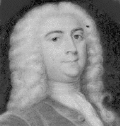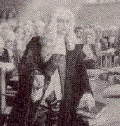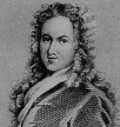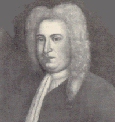
Governor William Cosby is generally portrayed as the villain of this story and, indeed, there is little to be said on his behalf. By all accounts, Cosby was spiteful, mean-spirited, quick-tempered, greedy, jealous, dull, and a petty tyrant. Too often many of these traits seemed to turn up among colonial governors who, overall, were quite a bad lot. There is a reason for this, according to one historian, who observed that governors consisted "most often of members of aristocratic families whose personal morals, or whose incompetence, were such that it was impossible to employ then nearer home."
Cosby arrived in New York to assume the governorship in August of 1731. His previous post (also with its controversies) had been in the Leeward Islands.
Cosby's decision to "go ballistic" and fire the Chief Justice of New York for daring to decide against him in a lawsuit--and then justify his decision in the New York Weekly Journal--was the trigger that started the Zenger affair in motion. The removal of Morris as Chief Justice, attempted election rigging, and the accepting of questionable honorariums were only a few of Cosby's actions that prompted condemnation in the Journal, and led to the eventual arrest and trial of the Journal's printer, John Peter Zenger.
Cosby died in New York on March 10, 1736.
John Peter Zenger neither wrote nor solicited the controversial editorials and satiric advertisements that appeared in his New York Weekly Journal. He did not set out to become a champion of free speech, but was simply a printer trying to make a go of it .
In many ways, however, Zenger is the true hero of this story. His decision to print James Alexander's attacks on the Governor Cosby's administration was done with full knowledge of the risks. Because of his decision, Zenger endured over eight months of very difficult conditions in New York City's Old Jail. Moreover, Zenger refused to bow to pressure--which might have helped his own cause considerably--to identify Alexander and others as the source of the offending articles.
Zenger's wife, Anna Zenger, also deserves mention. With her husband in jail and young children in the house, Anna Zenger somehow managed to keep the New York Weekly Journal publishing, missing only one issue. The continued publication of the Journal helped build public support for Zenger's cause and may have been instrumental in his ultimate acquittal.
Thirteen-year-old Zenger and his family made the arduous two-month crossing from their native Germany to America in 1710. His father died enroute to America and his mother was left to raise him and his siblings. Zenger's mother signed John as an indentured apprentice to New York's only printer, William Bradford. Zenger completed his indenture in 1718. He married the next year, but his wife soon died leaving him with an infant son. In 1722, Zenger married Anna Maulist, with whom he would share five more children.
Meanwhile, John Zenger continued to develop his skills as a printer. He entered into a partnership with Bradford in 1725, but left the next year to start his own print shop, only the second in the city of New York. For several years, Zenger printed mostly religious tracts until, in 1733, he was approached by James Alexander with the opportunity to print America's first party newspaper, the New York Weekly Journal.

If he did nothing else, Andrew Hamilton deserves fame for two remarkable accomplishments. The first, of course, was his brilliant, eloquent, and successful defense of John Peter Zenger on the charge of seditious libel brought against him by Governor Cosby. The second was an outgrowth of Hamilton's other interest, architecture. Hamilton designed the building in Philadelphia that would come to be known as Independence Hall, the site of the 1787 Convention that led to the drafting of the United States Constitution. Independence Hall still stands as perhaps America's most important historic landmark, drawing millions of tourists annually.
Hamilton was a native of Scotland who emigrated to Pennsylvania, where he became attorney general (1717-1724), speaker of the colonial assembly, and the most famous trial lawyer in the colonies. According to one historian of the time, Hamilton had "art, eloquence, vivacity, and humor, was ambitious of fame, negligent of nothing to ensure success, and possessed a confidence which no terrors could awe."
Hamilton was almost 60 when he accepted the request to take up Zenger's cause following the disbarment, for criticism of the court, of Zenger's first two attorneys. Hamilton won the Zenger case the only way that it could have been won, by convincing the jury to judge the law of the case, not just the facts. Legally, there is no question that Zenger committed seditious libel as it was defined in the law of the time, but the law itself was unpopular and Hamilton gave the jury the push it needed to decide Zenger's case in a way consistent with their own sympathies.
Andrew Hamilton died in 1741.
James Alexander both founded the New York Weekly Journal and was the principal author of the editorials and satiric pieces that so infuriated New York's governor, William Cosby.
As one of Zenger's two initial defense attorneys, Alexander challenged the legality to the two-judge court handpicked by Cosby to hear Zenger's case. For this action, Alexander was disbarred by one of the two judges, Chief Justice James Delancey.
Like Andrew Hamilton, James Alexander was a native of Scotland. Alexander emigrated to New York where he commenced his legal practice and became a leading member of the popular party--the party critical of Cosby and his policies. Alexander's good standing to practice law was eventually restored. In 1754, Alexander participated in the interprovincial conference in which Benjamin Franklin first proposed his plan for a formal federation of colonies. Alexander died in 1756, at age 65.

Opponents of Governor Cosby's policies were often called "Morrisites," after the governor's most visible critic, Lewis Morris. Morris was Chief Justice of New York when the matter of Cosby's suit against Rip Van Dam came before the Court. Alone among the three justices of the court, Morris decided against the legality of Cosby's attempt to do an end-run around the jury system and create a special court to hear the case. For this decision and his justification of the decision published in Zenger's New York Weekly Journal, Cosby removed Morris from office.
Following his removal from office, Morris ran as a popular party candidate for the post of assemblyman from Westchester. Cosby did what he could to rig the election against Morris, but his efforts fell short. The newly elected Morris was "saluted by a fire of general guns" and "conducted to the Black Horse Tavern, where a handsome entertainment was prepared for him."
Morris used his new position to continue criticism of the governor's often ham-handed efforts. In December 1733, Morris sailed to London where he presented officials with a laundry list of criticisms of Cosby. To his great disappointment, however, the criticisms fell largely on deaf ears.
In 1738, Morris was appointed governor of New Jersey. Lewis Morris died in 1746. His great grandson, Gouvernor Morris, became a key figure in the Constitutional Convention of 1787. Gouvernor Morris wrote the familiar words of the Preamble of the Constitution: "We, the people of the United States, in order to form a more perfect Union...."
James Delancey was a staunch royalist appointed Chief Justice of New York by Governor Cosby in 1733, following Cosby's firing of Chief Justice Morris for his refusal to see things his way in his lawsuit against Van Dam.
Delancey, while Chief Justice, also served as one of the two trial judges in the Zenger trial. Delancey did what he could do to secure Zenger's conviction. He disbarred Zenger's first two attorneys for daring to challenge the court that Cosby had appointed to try the Zenger case. He instructed the jury that its sole duty was to determine whether Zenger actually printed the allegedly libelous articles (a fact not disputed). He told the jury that the truth or falsity of the criticisms of Cosby was not relevant under the law--and that any such attacks on the governor's policies and competence was seditious libel as a matter of law.
Delancey was admitted to the New York bar in 1725, at age twenty-two. After the Zenger trial, Delancey would serve for a period as acting governor of New York, and would continue to be well-connected with establishment figures. He died in 1760.

When Governor Cosby arrived in New York in 1731, Rip Van Dam was the 71-year-old senior member of the New York Provincial Council and, in this capacity, served as acting-governor of New York until Cosby's arrival. When Cosby demanded that Van Dam split the salary he received for serving as acting governor, Van Dam responded by demanding that Cosby give him half of the perquisites Cosby had received after his appointment as governor, but before his arrival in America. By Van Dam's calculations, Cosby actually owed him money. Van Dam's stubbornness incurred Cosby's wrath, leading to the governor's lawsuit against Van Dam, the eventual removal of Chief Justice Morris, and finally to the Zenger trial itself.
Van Dam was born in Holland in 1660. He emigrated to New York, where he became a merchant and, in 1702, a provincial council member.
